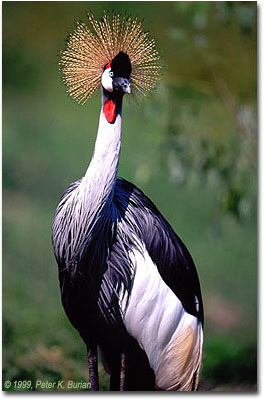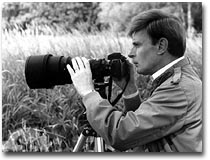
|

Photo Tip...
Fill Flash in Outdoor Photography
Text and Photography Copyright Peter K. Burian
All rights reserved.
|
Although some nature photographers reject electronic flash for outdoor work, many of us consider fill-flash indispensable in certain situations. Ambient light during much of an even splendid day can be harsh and overly contrasty, with hard shadows cast over the subject. In such circumstances, a reflector panel can be effective of course, as discussed in other Tips. However, fill-in flash can be just as useful and far more convenient or practical in some situations: in stiff wind when a reflector is blown around, when you don't have an assistant to hold a reflector, with subjects such as birds or mammals, and so on.
|

It's not difficult to acheive great lighting with high-tech cameras'
multi-segment meters and "smart flash" systems with Daylight Balanced Fill Flash.
Although the system already reduced flash output by 1.7 stops - automatically -
I wanted even more subtle lighting. Hence, I dialed in a minus
2/3 stop flash exposure compensation factor.
Controlled conditions; Canon EOS 1n, 540EZ speedlite on flash bracket,
Canon EF 300/2.8L IS, Fuji Provia 100F.
|
|
Has past experience led you to consider outdoor flash lighting as "artificial"? Or did you find that getting pleasing results was simply too complicated to achieve with the equipment of five or ten years ago. While both objections are understandable, the latest high-tech cameras -- combined with a dedicated multi-mode flash unit -- can help to achieve beautiful pictures without tedious calculations.
The Benefits of Fill Flash
The primary value of fill-in flash is simple: the extra light helps to even out contrast and to brighten shadow areas. In people pictures, it will soften unflattering facial shadows cast by a hat or even the nose. Or use it to add a sparkle to their eyes with a catchlight, or to brighten dark eye sockets created by sunlight from above. The same applies to animals too, and flash is particularly useful with dark species; the extra light reflecting from the eyes makes the subject seem to come alive in a photo.
In extremely contrasty conditions -- as in back lighting - fill flash helps to prevent one of two problems: 1) an underexposed subject or 2) a grossly over exposed background of bright sky, snow, water or beach. In order to extend the effective reach of flash, you may need to use a Fresnel lens accessory such as the Better Beamer marketed by NPN, Arthur Morris and others; use one of these only with lenses of 300mm or longer. You may also want to get the flash off-camera, using a TTL connecting cord and a flash bracket.
Working with High Tech Systems
Most high-tech SLR cameras today offer Daylight Balanced Fill Flash, at least in some operating modes. In bright conditions, they automatically reduce flash output by about 1.5 stops, balancing the flash intensity to that of the sunlight. You may still find flash output excessive. If your camera or flash unit has a Flash Exposure Compensation control, use it to decrease flash output. Try setting a -1 factor on sunny days; this will reduce flash output by an extra stop for a very subtle effect.
|
|
Note: Some photographers routinely recommend that you set a -2 to -3 or even a -4EV flash exposure compensation factor. However, this applies only when the camera is not already (automatically) reducing flash output in sunny conditions. With some models, you can disengage Daylight Balanced Fill Flash by setting a Custom Function. If you do so, then you will need to set a fairly significant minus flash exposure compensation factor for subtle fill-in lighting.
However, in strong backlighting, you will not want to set any minus flash exposure compensation if your camera is set for Daylight Balanced Fill Flash. In fact, you may need to dial in a +0.5 flash exposure compensation factor to avoid an under exposed subject. Naturally, this depends on the lighting situation, the subject, the metering pattern selected, and the tendencies of your camera's metering system.
Conclusion
All of this sounds a lot more complicated than it really is in practise, with one of today's "intelligent" multi-segment metering systems and "smart flash". Read your equipment Owner's Manuals closely and shoot a few rolls of slide film to experiment with the tendencies of your own equipment. Learn when to set flash exposure compensation, when fill flash is useful and when it is not desirable, and so on. Once you develop some expertise with fill flash in nature photography, you'll wonder how you ever got along without it.
 Peter K. Burian, a Charter member of NANPA, was the Editor of Shutterbug's OUTDOOR & NATURE Photography magazine for four years. He is a stock photographer and co-author of ten books, including nine Magic Lantern Guides to Minolta, Nikon and Canon systems and The National Geographic Photography Field Guide - Secrets to Making Great Pictures. He is also a regular contributor to photo magazines such as PHOTO LIFE, SHUTTERBUG, and AUSTRALIAN PHOTOGRAPHY, and Managing Editor with PhotoPoint.com. Mr. Burian can be reached at Pburian@aol.com.
Peter K. Burian, a Charter member of NANPA, was the Editor of Shutterbug's OUTDOOR & NATURE Photography magazine for four years. He is a stock photographer and co-author of ten books, including nine Magic Lantern Guides to Minolta, Nikon and Canon systems and The National Geographic Photography Field Guide - Secrets to Making Great Pictures. He is also a regular contributor to photo magazines such as PHOTO LIFE, SHUTTERBUG, and AUSTRALIAN PHOTOGRAPHY, and Managing Editor with PhotoPoint.com. Mr. Burian can be reached at Pburian@aol.com.
|
|

